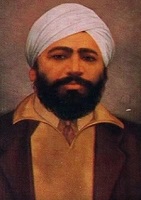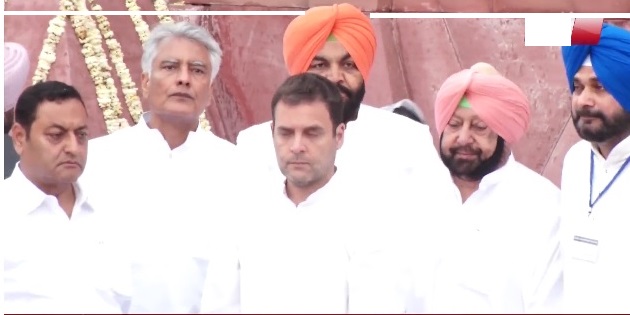Tribute To Freedom Fighter Udham Singh On His Death Anniversary ON July 31
Revolutionary freedom fighter was charged and hanged for killing General Michael O'Dwyer
- Udham Singh Death Anniversary: The revolutionary freedom fighter was charged and hanged for killing General Michael O'Dwyer. General O'Dwyer had ordered the massacre of hundreds of innocent Indians at Jallianwala Bagh.
| Udham Singh |
July 31, 2020 |
 |
Udham Singh is being remembered for his courage and determination, to free India from colonial rule, on his death anniversary today. The revolutionary freedom fighter was charged and hanged for killing General Michael O'Dwyer, at Pentonville Prison in London on July 31, 1940.
General Dyer opened fire on the peaceful gathering at Jallianwala Bagh on 13th April, 1919 as General Dyer wanted to enforce martial law very strictly in Amritsar. ... More than a thousand people and children were also killed in this accident and it is known as the Jallianwala Bagh Massacre |
NRIs and India marks 100 years of Jallianwala Bagh massacre
379 identified dead, 1,100 wounded, of which 192 were seriously injured
India Still Awaits Apology for Massacre in Amritsar
Udham Singh Waited 21 Years to Avenge Man Behind Jallianwala Massacre
Los Angeles, April 13, 2019
NRIpress.club/Ramesh/ A.Gary Singh
NRIs (Non-Resident Indians) around the world and Indians across the country paid tribute to those who lost their lives in the Jallianwala Bagh massacre on 13 April, 1919. The Jallianwalla Bagh is a public garden of 6 to 7 acres, walled on all sides, with five entrances.
The Jallianwala Bagh massacre took place when about 50 Indian British Army under the command of Colonel Reginald Dyer fired 1,650 rounds in 10 to 15 minutes. The Government of India published the report after The Hunter Commission’s report that at least 379 identified dead, with approximately 1,100 wounded, of which 192 were seriously injured. Heaps of dead bodies lay there, some on their backs and some with their faces upturned. A number of them were poor innocent children. Many local people tried to escape by scaling the high walls surrounding the garden. Others jumped into a deep, open well at the site as the troops fired..
For the past 100 years, Indians had hoped for a full and formal apology for the Jallianwalla Bagh massacre. In 1213, UK Prime Minister David Cameron’s floral tributes at the martyrs’ memorial and his comments in the visitors’ book did not go far enough. Staying close to the position that Winston Churchill took, Mr. Cameron said that Jallianwala Bagh was a “deeply shameful event in British history”. Mr. Churchill, the then Secretary for War, had called the incident an “outrage”.
British prime minister Theresa May said:
- The United Kingdom "deeply regrets" the massacre and called it a "shameful scar" on British-Indian history but stopped short of offering a formal apology.
Dominic Asquith, British High Commissioner to India visited the Jallianwala Bagh Memorial and wrote in the visitors' book:
- The events of Jallianwala Bagh 100 years ago today reflect a shameful act in British Indian history.
- I am pleased today that the UK and India have and remain committed to developing further a thriving 21st century partnership We deeply regret what happened and the suffering caused
| Rahul Gandhi, Congress president, Punjab Chief Minister Amarinder Singh and state minister Navjot Singh Sidhu |
 |
paid floral tributesat the Jallianwala Bagh Memorial on Saturday to mark the centenary of the Jallianwala Bagh massacre. Rahul Gandhi said:
- The cost of freedom must never ever be forgotten
- We salute the people of India who gave everything they had for it
They also went to the Golden Temple and paid obeisance at the Akal Takht, the highest temporal seat of the Sikhs. |
As Her Majesty The Queen said before visiting Jallianwala Bagh in 1997, it is a distressing example of our past history with India, we deeply regret what happened and the suffering caused.
"I'm pleased that today the UK-India relationship is one of collaboration, partnership, prosperity and security.
"Indian diaspora make an enormous contribution to British society, and I'm sure the whole house wishes to see the UK's relationship with India continue to flourish."
President Ram Nath Kovind and Prime Minister Narendra Modi paid tribute and said that the "stain on civilisation" would "never be forgotten" by India. "A 100 years ago today, our beloved freedom fighters were martyred at Jallianwala Bagh.
Kovind tweeted:
- A horrific massacre, a stain on civilisation, that day of sacrifice can never be forgotten by India.
- At this solemn moment, we pay our tribute to the immortals of Jallianwala." Kovind tweeted.
Modi wrote on Twitter:
- Today, when we observe 100 years of the horrific Jallianwala Bagh massacre, India pays tributes to all those martyred on that fateful day.
- Their valour and sacrifice will never be forgotten. Their memory inspires us to work even harder to build an India they would be proud of.
Jallianwala Bagh massacre: |
 |
 |
On April 13, 1919, at 9:00, the traditional festival of Baisakhi day, the civilians had assembled for a peaceful protest to condemn the arrest and deportation of two national leaders, Satya Pal and Saifuddin Kitchlew.
Colonel -acting Brigadier General, Reginald Dyer, the acting military commander for Amritsar announced the implementation of a pass system to enter or leave Amritsar, a curfew beginning at 20:00 that night and a ban on all processions and public meetings of four or more persons.
Dyer's force entered the garden, blocking the main entrance after them, took up position on a raised bank, and on Dyer's orders fired on the crowd for about ten minutes, directing their bullets largely towards the few open gates through which people were trying to flee, until the ammunition supply was almost exhausted.
On April 14, Dyer stated in a Report to the General Officer Commanding that “I hear that between 200 and 300 of the crowd were killed. My party fired 1,650 rounds.” |
The casualty number estimated by the Indian National Congress was more than 1,500 injured, with approximately 1,000 dead. This "brutality stunned the entire nation.
- The first report on the shooting, drafted by Amritsar’s Deputy Commissioner, Miles Irving, and sent to Punjab’s Lieutenant Governor, Michael O’Dwyer, in Lahore that night, put the crowd at some 5,000 and the figure of those killed at “about 200.
- The crowd was estimated by various sources to be anything between 10,000 and 30,000 and the number killed put variously at 800 to 1,000 and even more.
- The Principal of Amritsar’s Khalsa College, Gerard Wathen, put the figure at 1,042
Dyer was initially lauded by conservative forces in the empire, but in July 1920 he was censured and forced to retire by the House of Commons. The House of Commons, which voted against Dyer as a Colonel. He was disciplined by being removed from his appointment, was passed over for promotion and was prohibited from further employment in India. Some historians consider the episode a decisive step towards the end of British rule in India.
Udham Singh shot and killed Michael O'Dwyer in Britain on March 13, 1940: The assassination was in revenge for the Jallianwala Bagh massacre in Amritsar in 1919:
 |
Undam Singh witnessed a massacre and spent the rest of his life dreaming of getting his revenge. Udham Singh: Who Waited 21 Years to Avenge Man Behind Jallianwala Bagh Massacre |
 |
Udham Singh (26 December 1899 and – 31 July 1940), was a revolutionary belonging to the Ghadar Party and a well-known figure of the Indian independence movement.He is sometimes referred to as Shaheed-i-Azam Sardar Udham Singh. He was born as Sher Singh on 26 December 1899 at Sunam, Sangrur, Punjab. .His father, Sardar Tehal Singh Jammu, was a railway crossing watchman in the village of Upalli. He lost his parents when he was just a boy. A community orphanage in Amritsar took care of Singh and his older brother. In 1918 he cleared his matriculation examination.
- He was best known for his assassination in London of Michael O' Dwyer, the former lieutenant governor of the Punjab in India, on 13 March 1940.
- The assassination was in revenge for the Jallianwala Bagh massacre in Amritsar in 1919
- A district (Udham Singh Nagar) of Uttarakhand was named after him to pay homage in October 1995 by the then Mayawati governmen
|
On March 13, 1940, Udham Singh pulled out a .45 Smith & Wesson revolver that was concealed under a book in a meeting hall in London, and fired six rounds into a group of people. Two shots hit a Michael O' Dwyer,75-year-old man in the back, one bullet passing his right lung and heart, the other piercing both kidneys.
This quest took him to several continents and finally to England, where he watched and waited for years for the ideal opportunity to strike.He joined other Indian revolutionaries and visited many countries, the ultimate destination being London.
- He used several aliases, including Sher Singh, Udhan Singh and Ram Mohammed Singh Azad.
- He went to Africa in 1920 and tried to visit the United States but was initially unsuccessful.
- In 1924 he managed to reach America. In his three years there, he oversaw revolutionary activities, forming close links with the Ghadar Party and helping set up the Overseas Indians Association.
- In 1927 Udham Singh returned to India with more than two dozen aides and a cache of arms but he was arrested shortly afterwards and sent to five years’ jail under the Arms Act.
- After his release in October 1931, he kept a low profile for a while but then resumed underground activities, simultaneously looking at ways to reach Britain. The police kept a constant watch on him.
- In 1933, he travelled to Europe. After passing several countries he reached London in 1934. He stayed in a house in East London and joined a socialist organisation that worked for the cause of Indian workers.
During the trial Udham Singh said:
- :I did it because I had a grudge against Michael O’Dwyer. He deserved it. He was the real culprit.
- Michael O’Dwyer wanted to crush the spirit of my people, so I have crushed him.
- For full 21 years, I have been trying to wreak vengeance. I am happy that I have done the job. I am not scared of death. I am dying for my country.
- I have seen my people starving in India under the British rule. I have protested against this, it was my duty. What greater honour could be bestowed on me than death for the sake of my motherland?”
When Brigadier General Reginald Dyer opened fire on an unarmed gathering in Jallianwala Bagh. I was a witness to that carnage. Through 21 years of revolutionary activity in the United Kingdom, the United States, Africa and India, I saw avenging the massacre as his destiny. Jallianwala Bagh radicalised an entire generation and laid the foundation for Punjab’s vigorous secular political traditions.
He was arrested, convicted and sentenced to death on 31 July 1940 at Pentonville Prison.
|

|






